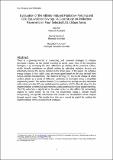Evaluation of the Albedo-induced Radiative Forcing and CO2 Equivalence Savings: A Case Study on Reflective Pavements in Four Selected U.S. Urban Areas
Author(s)
Xu, Xin; Gregory, Jeremy; Kirchain, Randolph
DownloadConference paper (345.8Kb)
Metadata
Show full item recordAbstract
There is a growing interest in developing cool pavement strategies to mitigate pavement’s impact on the global warming in recent years. One of the mitigation strategies is by increasing the solar reflectance (or albedo) of the pavement surface, which directly contributes to global cooling by adjusting radiative forcing and potentially reduces the energy demand in the urban areas. In this paper, the radiative energy budgets in four urban areas are investigated based on the data derived from NASA satellite measurements. The radiative forcing (RF) due to the change of urban surface albedo as a result of reflective pavements is estimated using a simplified engineering model. The carbon dioxide (CO2) equivalence savings are also calculated with reference to the 100-year global warming potential of CO2. Results show that the implementation of reflective pavement has a great potential to reduce global warming. The CO2 reduction is significant in the urban areas but also affects the surrounding regions to some extent. In the end, we recommend using a climate model incorporating site-specific information that enables the visualization of the outputs through spatial maps. The results from this work would be useful for guiding the implementation of the cool pavement strategies.
Date issued
2017-08-01Keywords
albedo, climate, Cool pavements, Urban environments, Global warming, CO2 Reduction